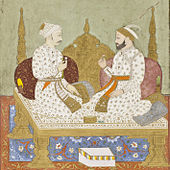Jai Singh II
Sawai Jai Singh II (born November 3, 1688 in Amber ; † September 21, 1743 in Jaipur?) Was Maharaja of Amber (later Jaipur ) in Rajasthan , India . He was in the military service of the Grand Mogul Aurangzeb and his successor before he pursued a more and more independent politics since the middle of his life.
biography
After the death of his father Bishan Singh on December 31, 1699, Jai Singh was proclaimed his successor at the age of only 11 years. From the Mughal Mughal Aurangzeb (r. 1658–1707), who had appointed him to the court of Delhi , he received the honorary title of Sawai at a young age because of his intelligence and his lively manner . However, the inherited principality of Amber was on the verge of financial and political ruin. At the age of 12, Jai Singh was supposed to take part in the Deccan Wars - he reached Burhanpur in August 1701 , but he and his troops were prevented from advancing for a long time by heavy monsoon rains , whereupon Aurangzeb reduced his pay and his rank in September downgraded.
The Mughal Mughal died in 1707, which initially did not change the precarious situation of Jai Singh. Under Aurangzeb's successor Bahadur Shah I (r. 1707-1712), he allied himself with the princes of Mewar and Marwar and drove the hated Mughals from Rajputana . Nevertheless, Bahadur Shah appointed him governor of the provinces of Agra and Malwa . Here he had to deal with attacks by the Jats , who had also suffered from Aurangzeb's repressive policies. The Jats were also unpopular with the Rajputs and so a Rajput coalition with financial support from the Mughal court succeeded in putting an end to the independent efforts of the Jats. Between 1714 and 1737 Jai Singh was - with interruptions - appointed governor ( subahdar ) of Malwa province three times , where he was again drawn into the conflicts with the Jats and the Marathas . During his third term in office, he allied himself with the marathan leader Chhatrapathi Shahu , who in 1737 was almost able to take Delhi, the capital of the increasingly weaker Mughal empire.
Over the years he pursued an expansion policy in Rajputana, financed by tribute payments and military conquests, which culminated in the annexation of the prosperous Shekhawati trade region . He had an army of around 40,000 men under his control, which he also brought up to date with the latest military technology - especially the artillery was expanded and equipped with the largest gun mount of the time ( Jaivana ).
Culture
Jai Singh was the first Hindu ruler in centuries to perform the Vedic horse sacrifice ( ashvamedha ) (1716) and a few years later also the fire sacrifice ( vajapeya or yajna ). He promoted Sanskrit lessons and banned widow burning, which was still practiced in the countryside and in the cities . In the years after 1719, after a discussion at the Mughal court, he came to the conclusion that mathematical and astronomical knowledge were important for his people and set up observatories ( jantar. ) In several cities of the empire he controlled ( Jaipur , Delhi , Ujjain , Mathura and Varanasi ) mantar ), of which that no longer exists in Mathura. In 1725 he commissioned his architects with the planning for the city of Jaipur, which was later named after him, for which he ordered a straight road network and a uniform color of the buildings; Construction began in 1727 and in 1733 Jaipur became the new capital of his empire.
Succession
After Jai Singh's death, a war-like battle for the succession broke out between his sons, the half-brothers Ishwari Singh (r. 1743-1750) and Madho Singh I (r. 1750-1768), which the former initially won.
literature
- Jadunath Sarkar : A History of Jaipur. Orient Longman, New Delhi 1984, ISBN 81-250-0333-9 .
- Jafa Jyoti: Royal Jaipur. Roli Books, New Delhi 2005, ISBN 81-7436-177-4 .
Web links
| personal data | |
|---|---|
| SURNAME | Jai Singh II |
| ALTERNATIVE NAMES | Sawai Jai Singh II. |
| BRIEF DESCRIPTION | Maharaja |
| DATE OF BIRTH | November 3, 1688 |
| PLACE OF BIRTH | Amber |
| DATE OF DEATH | September 21, 1743 |
| Place of death | unsure: Jaipur |


